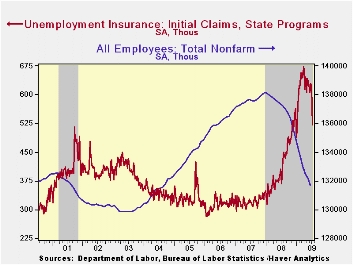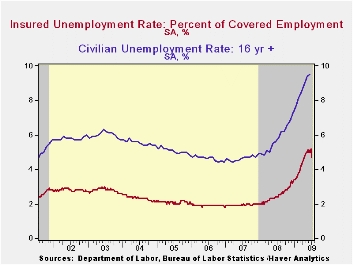 Global| Jul 16 2009
Global| Jul 16 2009Sharp Decline In U.S. Claims For Jobless Insurance Suggests Labor Market Improvement
by:Tom Moeller
|in:Economy in Brief
Summary
Conditions in the labor market improved further last week as evidenced by a sharp decline in both initial and continuing claims for unemployment insurance. For the second consecutive week, the report on initial claims was surprising. [...]

Conditions in the labor market improved further last week as evidenced by a sharp decline in both initial and continuing claims for unemployment insurance. For the second consecutive week, the report on initial claims was surprising. A 47,000 drop to 522,000 which followed a similar decline during the prior week. The latest level was the lowest since the first week of January and it was off from the March peak of 674,000. The four-week average of claims, which smoothes out some of the volatility in the weekly numbers, also fell to 584,000. The latest weekly level was quite a bit lower than Consensus expectations for 554,000.
The Labor Department indicated that the largest decreases in initial claims for the week ending July 4 were in New Jersey (-5,030), California (-4,293), North Carolina (-3,983), Kansas (-3,544), and Oregon (-1,454) while the largest increases were in Michigan (+12,144), New York (+8,913), Wisconsin (+5,838), Indiana (+5,430), and Ohio (+4,240).
Confirming the labor market's improvement was a 642,000 drop in continuing claims for unemployment insurance to the lowest level since mid-April. The continuing claims figures lag initial claims by one week and provide an indication of workers' ability to find employment. At 6,273,000 claims still were nearly double the year ago level. The four-week average of continuing claims fell back to 6,666,750 which was the lowest since mid-May. The series dates back to 1966.
The insured rate of unemployment dropped sharply to 4.7% which was the lowest level since mid-April. During the last ten years there has been a 93% correlation between the level of the insured unemployment rate and the overall rate of unemployment published by the Bureau of Labor Statistics.
The highest insured unemployment rates in the week ending June 27 were in Michigan (7.2 percent), Puerto Rico (6.9), Oregon (6.5), Pennsylvania (6.3), Nevada (6.1), Wisconsin (5.8), California (5.4), South Carolina (5.4), Connecticut (5.2), Illinois (5.2), New Jersey (5.2), and North Carolina (5.2). Rates were lowest in Texas (3.0), Wyoming (3.2), Colorado (3.2), Maine (3.4), Maryland (3.6), Minnesota (4.0), Florida (4.1), Georgia (4.2) and Mississippi (4.3).
The unemployment insurance claims data is available in Haver's WEEKLY database and the state data is in the REGIONW database.
The minutes to the latest FOMC meeting can be found here.
| Unemployment Insurance (000s) | 07/11/09 | 07/04/09 | 06/27/09 | Y/Y | 2008 | 2007 | 2006 |
|---|---|---|---|---|---|---|---|
| Initial Claims | 522 | 569 | 617 | 34.9% | 420 | 321 | 313 |
| Continuing Claims | -- | 6,273 | 6,915 | 97.9% | 3,342 | 2,552 | 2,459 |
| Insured Unemployment Rate (%) | 4.7 | 5.2 | 2.4 | 2.5 | 1.9 | 1.9 |
Tom Moeller
AuthorMore in Author Profile »Prior to joining Haver Analytics in 2000, Mr. Moeller worked as the Economist at Chancellor Capital Management from 1985 to 1999. There, he developed comprehensive economic forecasts and interpreted economic data for equity and fixed income portfolio managers. Also at Chancellor, Mr. Moeller worked as an equity analyst and was responsible for researching and rating companies in the economically sensitive automobile and housing industries for investment in Chancellor’s equity portfolio. Prior to joining Chancellor, Mr. Moeller was an Economist at Citibank from 1979 to 1984. He also analyzed pricing behavior in the metals industry for the Council on Wage and Price Stability in Washington, D.C. In 1999, Mr. Moeller received the award for most accurate forecast from the Forecasters' Club of New York. From 1990 to 1992 he was President of the New York Association for Business Economists. Mr. Moeller earned an M.B.A. in Finance from Fordham University, where he graduated in 1987. He holds a Bachelor of Arts in Economics from George Washington University.






